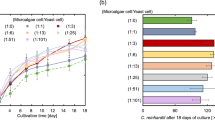Summary
Enzymatic and genetic evidence are presented for a new pathway of ammonia assimilation in nitrogen fixing bacteria: ammonium → glutamine → glutamate. This route to the important glutamate-glutamine family of amino acids differs from the conventional pathway, ammonium → glutamate → glutamine, in several respects. Glutamate synthetase [(glutamine amide-2-oxoglutarate aminotransferase) (oxidoreductase)], which is clearly distinct from glutamate dehydrogenase, catalyzes the reduced pyridine nucleotide dependent amination of α-ketoglutarate with glutamine as amino donor yielding two molecules of glutamate as product. The enzyme is completely inhibited by the glutamine analogue DON, whereas glutamate dehydrogenase is not affected by this inhibitor; the glutamate synthetase reaction is irreversible. Glutamate synthetase is widely distributed in bacteria; the pyridine nucleotide coenzyme specificity of the enzyme varies in many of these species.
The activities of key enzymes are modulated by environmental nitrogenous sources; for example, extracts of N2-grown cells of Klebsiella pneumoniae form glutamate almost exclusively by this new route and contain only trace amounts of glutamate dehydrogenase activity whereas NH3-grown cells possess both pathways. Also, the biosynthetically active form of glutamine synthetase with a low K m for ammonium predominates in the N2-grown cell.
Several mutant strains of K. pneumoniae have been isolated which fail to fix nitrogen or to grow in an ammonium limited environment. Extracts of these strains prepared from cells grown on higher levels of ammonium have low levels of glutamate synthetase activity and contain the biosynthetically inactive species of glutamine synthetase along with high levels of glutamate dehydrogenase. These mutants missing the new assimilatory pathway have serious defects in their metabolism of many inorganic and organic nitrogen sources; utilization of at least 20 different compounds is effected. We conclude that the new ammonia assimilatory route plays an important role in nitrogenous metabolism and is essential for nitrogen fixation.
Similar content being viewed by others
Abbreviations
- DON:
-
6-diazo-5-oxo-l-norleucine
References
Arnon, D. I., Das, V. S. R., Anderson, J. D.: Metabolism of photosynthetic bacteria. In: Studies on microalgae and photosynthetic bacteria. Special issue, pp. 529–545 (1963).
Benemann, J. R., Yoch, D. C., Valentine, R. C., Arnon, D. I.: The electron transport system in nitrogen fixation by Azotobacter. Proc. nat. Acad. Sci. (Wash.) 64, 1079–1086 (1969).
Carnahan, J. E., Mortenson, L. E., Mower, H. F., Castle, J. E.: Nitrogen fixation in extracts of Clostridium pasteurianum. Biochim. biophys. Acta (Amst.) 38, 188–189 (1960).
Elmerich, C., Aubert, J.: Synthesis of glutamate by a glutamine: 2-oxoglutarate amidotransferase (NADP oxidoreductase) in Bacillus megaterium. Biochem. biophys. Res. Commun. 42, 371–377 (1971).
Hartman, S. C.: Glutaminase of Escherichia coli. J. biol. Chem. 243, 853–863 (1968).
Holzer, H.: Regulation of enzymes by enzyme catalyzed chemical modification. Advanc. Enzymol. 32, 297–326 (1969).
Klucas, R. V., Koch, B., Russell, S. A., Evans, H. J.: Purification and some properties of nitrogenase from soybean (glycine max merr.) nodules. Plant Physiol. 43, 1906–1912 (1968).
Lascelles, J.: The synthesis of porphyrins and bacteriochorophyll by cell suspensions of Rhodopseudomonas spheroides. Biochem. J. 62, 78–93 (1956); as modified by Buchanan, B., M. C. W. Evans, and D. I. Arnon: Ferredoxin-dependent carbon assimilation in Rhodospirillum rubrum. Arch. Mikrobiol. 59, 32–40 (1967).
Miller, R. E., Stadtman, E. R.: Purification and properties of glutamate synthetase of E. coli. Fed. Proc., p. 1067 (1971).
Pengra, R. M., Wilson, P. W.: Physiology of nitrogen fixation by Aerobacter aerogenes. J. Bact. 75, 21–25 (1958).
Pfennig, N.: Eine vollsynthetische Nährlösung zur selektiven Anreicherung einiger Schwefelpurpurbacterien. Naturwissenschaften 48, 136 (1961).
—: Beobachtungen über das Schwärmen von Chromatium okenii. Arch. Mikrobiol. 42, 90–95 (1962).
Roth, J.: Genetic techniques in studies of bacterial metabolism. In: Methods of enzymol., vol. XVII, Part A, pp. 3–35 (1970).
Shapiro, B. M., Stadtman, E. R.: The regulation of glutamine synthesis in microorganisms. Ann. Rev. Microbiol. 24, 501–524 (1970).
Stadtman, E. R., Ginsburg, A., Ciardi, J. E., Yen, J., Hennig, S. B., Shapiro, B. M.: Multiple molecular forms of glutamine synthetase produced by enzyme catalyzed adenylylation and deadenylylation reactions. Advanc. Enzyme Regulat. 8, 99–118 (1970).
Streicher, S., Gurney, E., Valentine, R. C.: Transduction of the nitrogen-fixation genes in Klebsiella pneumoniae. Proc. nat. Acad. Sci. (Wash.) 68, 1174–1177 (1971).
Tempest, D. W., Meers, J. L., Brown, C. M.: Synthesis of glutamate in Aerobacter aerogenes by a hitherto unknown route. Biochem. J. 117, 405–407 (1970).
Author information
Authors and Affiliations
Rights and permissions
About this article
Cite this article
Nagatani, H., Shimizu, M. & Valentine, R.C. The mechanism of ammonia assimilation in nitrogen fixing bacteria. Archiv. Mikrobiol. 79, 164–175 (1971). https://doi.org/10.1007/BF00424923
Received:
Issue Date:
DOI: https://doi.org/10.1007/BF00424923




